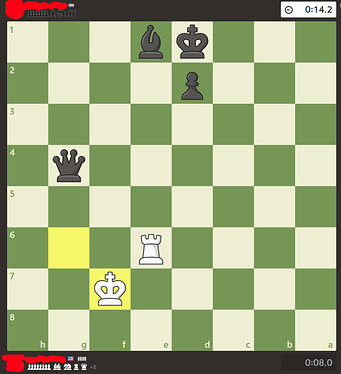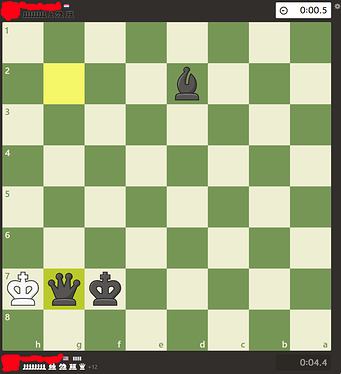I’ve been doing the same thing, spending 3 or 4 hours a day on it 
Yes, that’s it.
It’s a good way to sharpen your brain. 
The time controls are always X+Y, where X is the number of minutes each player starts with and Y is how many additional seconds they get per move.
I’ve been playing a bunch of 5+0 blitz lately after mostly playing 15+10 before this. Managed to drag my rating up from 900 to around 1175 over the past few weeks. Still terrible, but I’m definitely getting better at spotting tactics and attacking opportunities.
Yeah my lichess 15+10 was in the 1500s somewhere, but I’ve mostly been playing at chess.com for the past few months. I figure if I keep getting my butt kicked by 1200s at chess.com I have no business being that rating over there so I’ve gotta do some grinding.
Yeah you’ve got to be prepared to fight dirty at blitz because 100% of your opponents at chess.com will try to win on time even if they’re down a queen and pieces lol.
It’s very annoying but it does help you find mating patterns quickly.
Yes that’s pathetic at x+3.
I do usually report them if they refuse to find the resign button, not that it does any good. Even worse than that imo are the players who just let their clocks run down in lost positions.
Lol this reminds me of when the.bayare.ab…east told everyone he was a chess genius and then it turned out he was just shuffling pieces back and forth trying to win blitz games on time.
I usually do better in fast games, I am ok at end games and finding lines to mate quickly. I usually just try to get a decent position early and start trading material like a madman to force an endgame where people typically make massive mistakes at my very low rating.
Random tip: if you play blitz with no time increment and you’re not pre moving, you’re doing it wrong. If you have any relatively easy endgame like rook+, you should be able to pre move into mate given 10 seconds, even if you need 20 moves.
Yeah lichess requires a little more micro, but you basically have to get into the pre move mindset earlier. Also often doing 3 or 4 pre moves in a row (on lichess) is better on the clock than thinking for 2 seconds to find the most efficient move. The more confident you are you can convert easy endgames with little time, the more time you give yourself to think earlier in the game.
Here’s a good example of a game I just played on chess com with pre moving
Good battle leading up to this, I’m Black but he has 14 seconds and I have 8 seconds in this position
There are a thousand ways to win but with this amount of time I secure the draw first by taking rook with queen, then I pre move: my king away, queen the pawn (in .2 seconds), and then I start marching the king to center, aiming to restrict his king to g/h file with queen but also avoiding stalemates

Ending here at move 79 for 12 moves in 3.6 seconds (the .1s on the scoresheet are the pre moves)
Thanks! I didn’t know chess.com allow 5 pre-moves.
There’s always the risk of bundering with one, which does happen occasionally. Recently as black I played f5 when a white pawn was on e5 and pre-moved Nf6, expecting to retake his pawn after his en-passant capture which unfortunately didn’t come, costing me my knight lol.
Still not as bad as the IM who as black famously told his opponent in a correspondence game that he’d play the Modern 1…g6 and 2…Bg7 whatever the opening.
His opponent of course played 1. d4, 2. Bh6 and 3. Bxg7
I am a total chess noob. I know the rules and have played many times but know zero strategy. What’s my best app/tool to learn?
Diamond membership chess.com. Tutorials, tactics trainers, video lessons, Silman articles and of course playing lots and lots of games.
Just got pitted against a Russian called White-Pride on chess.com. Reported him (after beating him).
Find an old copy of Chessmaster 9000 and watch the Josh Waitzkin lectures.
John Bartholemew’s videos on youtube are great - particularly the “Chess Fundamentals” and “Climbing the Rating Ladder” videos. Eric Rosen and GothamChess are also good for instructional content. but I find Bartholomew to be the best at teaching out of the bunch.
Chessable.com has a bunch of free courses on basically any opening you want.
@clovis8 same question was just asked on LC thread, my response is here. As long as you feel like you’re generally losing or winning games because someone hangs a piece, tactics training is the answer. After that I’d probably recommend watching agadmator’s videos - although not the Morphy saga he’s doing at the moment, I think it’s more instructive watching modern masters. I personally find being shown the correct answers over and over again with explanation a better way of learning than trying to read theory. His videos are a nice accompaniment to a morning coffee.
Just for you Clovis, I’m going to write up some crucial positional ideas for intermediates. I am a strong intermediate myself (1700-1800 5+0 chess com). These are all generally interrelated.
1. Central Control
The center is the squares e4, d4, e5, d5 and to a lesser extent all the squares which surround those four. Central control basically gives you a lot more freedom to move your pieces. It’s difficult to move your pieces from one side of the board to another if you have no space in the center, for example if you are black and e6 and d6 are not available, you are very cramped.
2. Space
Space is a more general idea of control of territory via pawns; central control is a special case of this. If you advance your pawns, space behind them will appear for your pieces to move. This exists in tension with the idea of pawns being overextended; you must be able to defend your pawns lest they become a weakness. Which brings me to:
3. Pawn Weaknesses
“Pawns are the soul of chess” - Philidor, 1749
“The pawn, as Philidor put it, is the soul of chess, and we can add that in the ending it is nine-tenths of the body as well” - Reuben Fine, 1941
I could have put this at #1 as it’s the most common way (other than them hanging a piece) of gaining advantage against bad players. Pawn weaknesses come in three basic flavours: backward, doubled, and isolated (also overextended, as discussed last point, however whether an extended pawn is a strength or a weakness is often unclear even in master games). Having multiple of these deficiencies compounds the weakness. Having more pawn islands than your opponent is a weakness akin to isolation. Weak pawns are liable to be targeted. Either they will end up captured, or you will be forced into a passive position to defend them. Passivity is as bad at chess as it is at poker. Frequently pawn weaknesses arise as a tradeoff against accomplishing other goals. That’s fine, but don’t create them needlessly. Experience is the teacher of when pawn weaknesses are OK; watching master games is an exceptional way to learn about this.
4. Good and Bad Pieces
Good pieces are pieces which have a lot of potential moves and exert control over useful squares; bad pieces control no useful territory. A good rule of thumb if you can’t come up with a plan in a position is to find your worst piece and improve it. Activating pieces is a very common reason for pawn sacrifices in master games; very frequently changes in the pawn structure can make good pieces bad and vice versa, keep a lookout for such ideas.
5. Color complexes
This is heavily linked up with good and bad pieces. Your bishops are special pieces that only operate on one square color. Your pawns should complement your bishops, so if you have a dark squared bishop, it will be much happier if your pawns are on light squares. This is especially true if your opponent has a light squared bishop and you don’t. In that case, your pawns on light squares serve to limit your light-square disadvantage. This advice applies to the middlegame only. In endgames, it’s often better to place your pawns on the opposite color to an opponent bishop to avoid them becoming targets. The relevant question is whether you want your pawns to be doing work for you, or whether they are simply assets you’re trying to preserve.


